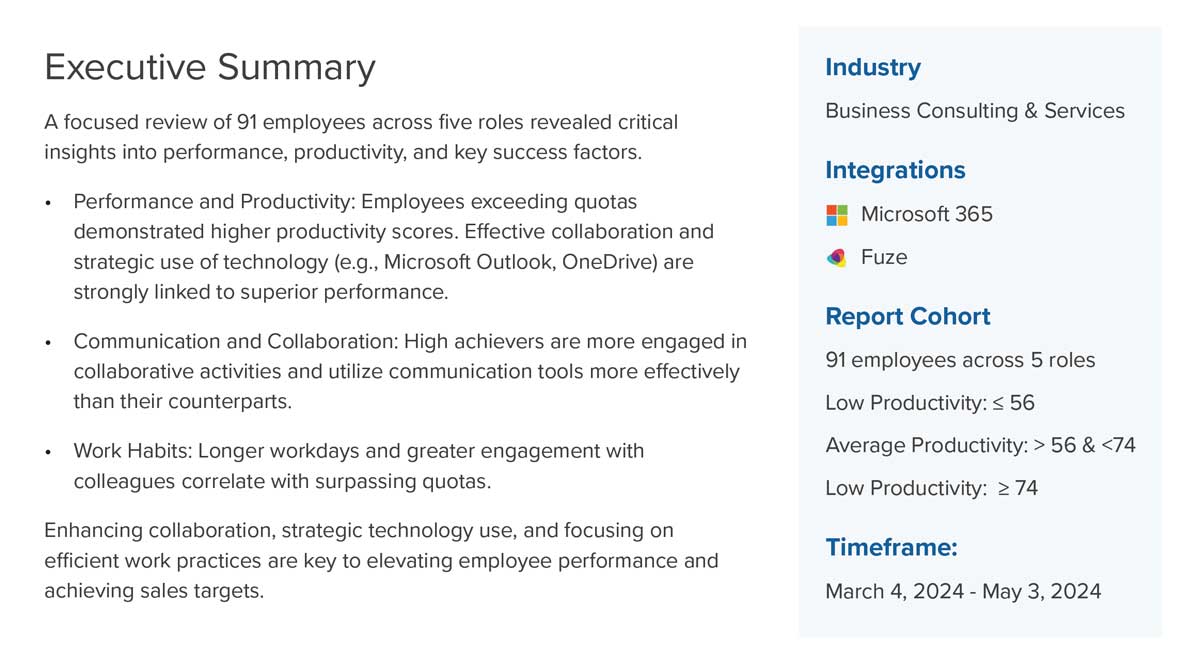Using Custom Employee Productivity Metrics To Improve Performance
Most modern organizations track performance metrics to measure success and create a baseline that makes it possible to improve. Some of the most common metrics to track are:
- Business Performance
- Sales Performance
- Project Management Performance
- Employee Performance
Building upon the foundation of standard performance metrics, custom employee productivity metrics offer a more tailored approach to understanding and enhancing workforce efficiency. These metrics delve deeper than simple output tracking, considering factors unique to a company's operations, workflows, and specific goals.
For instance, one business might focus on measuring the effectiveness of cross-departmental communication, while another might prioritize tracking the speed and quality of customer issue resolution. By customizing the metrics, organizations can pinpoint the areas needing improvement, leading to more focused interventions and impactful results.
Creating the Right Productivity Metrics for Your Business
Employee productivity data specifically provides leading performance indicators and can support business leaders in making more informed decisions that help drive success. Companies can gain valuable insights into departmental and individual strengths and weaknesses by analyzing metrics such as time spent in tools, collaboration efforts, and general activity trends.
This data enables organizations to identify areas needing improvement, reward top performers, redistribute duties effectively, and implement targeted coaching and training programs, ultimately leading to enhanced productivity and better business outcomes.
The process of developing custom productivity metrics involves several key steps. First, it's essential to identify the core objectives and key performance indicators (KPIs) that drive the business. What specific behaviors and actions lead to desired outcomes? Once these are established, appropriate metrics can be designed to capture and measure them. This might involve tracking the utilization of specific software tools, quantifying the frequency and effectiveness of collaboration, or evaluating the speed and accuracy of task completion. Ensuring these metrics are measurable, relevant, and consistently tracked is crucial to provide valuable insights over time.
Types of Workplace Productivity to Measure
1. Department-Wide Productivity
Assessing a department's productivity can help pinpoint which departments are more productive than others. Here, we suggest the types of metrics that can be used for different departments. This data highlights where more attention is required or which departments should be rewarded. It can also assess department tool utilization and potentially flag opportunities for license optimization or training gaps.
2. Productivity By Role
Breaking down productivity by role can draw attention to roles that require additional support or coaching. It also creates an opportunity to compare people within those roles to find rising stars, or employees who may be a better fit for a different role.
Higher Productivity, Higher Performance
For one company, an evaluation of department performance confirmed that higher employee productivity translated into better performance. Based on a Prodoscore study, we found that for each point increase in an individual’s Prodoscore, there was a 7.6% increase in year-to-date percentage quota, or the percentage of an annual quota achieved year-to-date. The report captured specific activities that correlated with higher outputs. These included:
- Staff who surpassed quotas had higher productivity scores
- Those with higher scores engaged in more communication and collaboration
- Longer workdays and more engagement with colleagues contributed to surpassing quotas
- Strategic technology use (OneDrive in this case) was strongly linked to better performance, likely because people using OneDrive were collaborating on projects

Interestingly, this report showed that longer tenure did not correlate with better performance, and utilization of certain applications, like Outlook meetings, correlated with lower performance. This could suggest that lower performers had too many meetings and/or overemphasized less productive activities. With this insight, business leaders can make adjustments that will have far-reaching benefits across an organization, whether that means coaching low performers up or out, or pinpointing what’s working in order to replicate.
These observations highlight a common trend: focusing on productive behaviors like communication, collaboration, and strategic technology use directly correlates with improved performance across various roles and industries.
Utilizing Metrics in Performance Reviews
Once you’ve identified the right metrics for your business and understand how they correlate to KPIs and overall success, you can integrate them into employee performance reviews and feedback sessions. Incorporating metrics as a core component of the evaluation process makes it easier for employees, managers, and leaders to adopt the data and adjust to ensure they remain relevant and effective.
Importantly, the selected metrics must be directly tied to employee roles and responsibilities and the overall team and company goals. During reviews or feedback sessions, discuss the data points and trends observed, highlighting areas of strength and areas for improvement. Use specific examples from the data to illustrate points and provide constructive feedback. Setting collaborative goals based on these metrics will also help establish clear expectations and action plans for improvement and provide context for the input.
Ultimately, leveraging custom employee productivity metrics empowers businesses to move beyond generic performance evaluations and gain a granular understanding of how work is being accomplished. Remember, higher productivity often translates to higher performance, and by focusing on the activities that correlate with success, companies can make decisions that drive the business forward.
